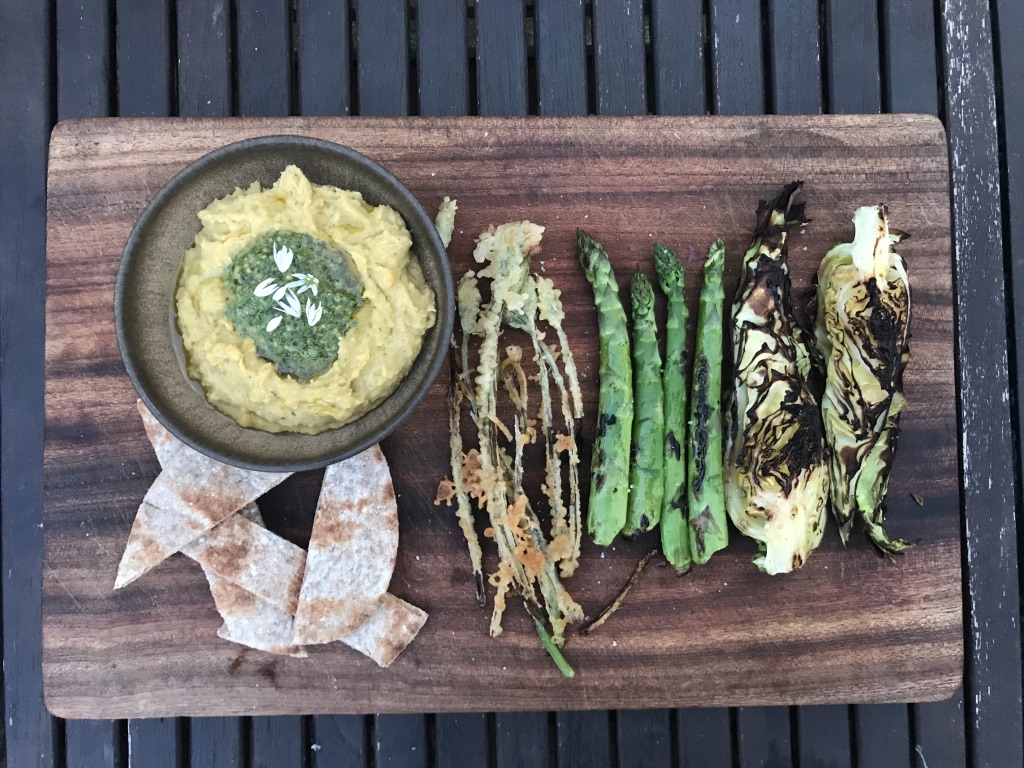With Shambala HQ closed for the time being and the team working from home, one of the things we are missing the most is being fed by Shambala co-founder and our in-house chef extraordinaire, Oli.
Luckily, he’s been teaching us to make delicious, locally sourced, immunity boosting treats from the comfort of our own homes – and we wanted to share one of his amazing recipes with you lot…
PEASE POTTAGE, GREEN SALSA & SIDES
A wee history lesson:
- Researchers believe that split peas go back 5,000 years and originate in Africa and Asia and very quickly migrated west.
- Pease Pottage or Pease Pudding was a medieval staple dish made of boiled legumes, typically yellow split peas along with other ingredients (often Pork bones and ham and spices) that were easily available and generally served with bread.
- It could be kept over the fire for a number of days, eaten hot or cold and was ever changing as more ingredients were added.
The dish coupled with the knowledge of incredible UK grain and legume producers, inspired the idea for a giant pot of Pease Pottage over a wood fire at the Garden o Feeden this year to accompany the bread bar. Using only UK ingredients, including any from our traders that would otherwise go to waste, we could create a very low carbon impact dish that is highly nutritious. Shambalans could then pay what they want for it – or help out and get a bowl free. In the meantime, we’ve been making it at home instead!
Oli is using only UK ingredients that are readily available for this recipe. (If he wasn’t using just UK ingredients, he’d be adding spices, lemon and lime juice..)
This dish calls for your favourite loaf of bread or a delicious flat bread as a side.
Pease Pottage (Serves 4)
Any legume will work for this recipe, although the cooking times will vary.
The stock you use for this dish will be the main flavour of the Pottage. Oli uses a mushroom and kelp seaweed stock but there are some great mushroom stock cubes on the market and any stock or stock cube will work – even just water.
You may well have leftovers of this pottage but it will keep for at least 3 days in the fridge or kept frozen and can be served cold and added to with many a condiment, much like a hummus.
Ingredients
- 335g x Split Yellow Peas, preferably soaked in cold water for 6 hrs but not essential
- 1x Onion, medium to large, peeled and diced
- 1 x Garlic Bulb, peeled and chopped
- 1 ltr x Stock of your choice (most individual stock cubes require 500ml of water each)
- 1 tbsp. x Malt Vinegar, any vinegar will work or lemon or lime juice
- 40ml x Oil, any type will do
- Sea Salt to taste
- Optional – Sprigs of fresh Thyme, Rosemary and Bay Leaf – any combo
Method
On a low heat, gently fry the onions and garlic with a splash of oil and a pinch of salt in a large/ish heavy based pot or pan, stirring regularly until the mixture is soft.
Meanwhile, drain your soaked split peas or alternative legume in a colander, get your stock hot and if you’ve got them, tie your herbs with some food safe string or make a bomb of them in some cotton.
After the 20 minutes, when the onions are soft, add the peas, the stock and herbs. Turn up the heat and stir thoroughly.
When it’s reached a boil, turn down the heat and continue to simmer, stirring regularly, until your legume is tender (the manufacturers label will detail cooking times for your chosen legume).
Using a blender or hand blender or masher or even a fork, mash the peas up until you get your desired texture although this stage is not essential. You may want to add more stock or hot water for your desired consistency – legumes can get claggy.
Now to finish, add your vinegar or lemon juice and sea salt to your taste. Please remember that the salsa that will accompany the dish, will liven/freshen up the savoury notes of the pottage so go easy on the vinegar or lemon.
Green Salsa (Serves 4)
Chef’s notes:
As an alternative to the wild greens listed below (which are highly nutritious and readily available most of the year, if not all year round except the wild garlic), you can use any combination of soft herb or brassica such as kale. The point of this part of the dish is to create an acidic dressing that will cut through the savoury profile of the pottage.
Wear gloves when picking and washing nettles. To take the sting away, blanch handfuls at a time for 10 seconds in boiling water and shock in a bowl of iced or cold water. Some cooks like to do the same with wild garlic leaves to take the sharp edge of the flavour away.
Roast the whole garlic bulbs in advance. The roasted garlic adds a great depth of flavour to many a sauce – place whole garlic bulbs in their skin on a baking tray in a pre-heated oven at 180’C for 30 minutes and leave to cool (they last for at least a week in the fridge). Then, slice the whole root end off the garlic bulb and push the caramelised insides out leaving just the skin to discard – there are some garlic bulbs which are too delicate and will make this a tedious process so best to choose larger, robust garlics if you can.
Ingredients
- 50g x Stinging Nettles, younger the better, washed in cold water, blanched, shocked and drained
- 35g x Wild Garlic leaves, washed in cold water, blanched, shocked and drained
- 10g x Dandelion Leaves, washed in cold water and drained
- 5g x Cleavers/Sticky Willy/Goosegrass, washed in cold water and drained
- 1 x Garlic, Roasted Whole and insides squeezed out
- 60ml x Cider Vinegar (any vinegar will work. Lemon or lime Juice is best but it’s rarely from the UK! Shame… it’s so fresh!)
- 150ml x Oil, any type will do.
- Sea Salt to taste
- Optional – 50g x blanched Hazelnuts or Walnuts or any nut or seed, toasted until golden. Chilli, fresh parsley and coriander also works very well.
You may well have leftovers – this salsa keeps well in a fridge for at least 3 days and works as a dip or add some grated parmesan with the nuts crushed to make a pesto.
Method
Roughly chop your prepped greens and don’t worry if they’re still a bit wet after washing them.
In a blender or large pestle and mortar, blitz the nuts until coarsely ground.
Now add the greens to the blender (a handful at a time if your blender’s small) along with the roasted garlic, vinegar (or lemon or lime juice) and a good pinch of sea salt.
Blitz and then slowly add the oil. Taste test – you may want to add more vinegar or oil and sea salt until it tastes like a tart dressing.
Optional Sides if you’re feeling adventurous :
Tempura Wild Garlic Scrapes (Serves 4)
Scrapes are the long, leafless flowering stem rising directly from the underground bulb. Wild garlic is in season in the UK from late winter to the end of spring – the scrapes will start showing after the leaves.
Ingredients
- 4 Handfuls x Wild Garlic Scapes, washed and drained
- 65g x Flour, any flour or any combination of flours will do
- 2 Lrg pinches x Sea Salt
- 150ml x Cold water
- Good glug of Oil for the pan
Method
In a large mixing bowl, whisk the flour/s with the water and a couple of good pinches of sea salt until the mixture is consistent.
Line a plate with a fine layer of flour.
Place a frying pan on a medium heat and add a good glug of oil.
Using one handful of scrapes at a time, roll them in the dry flour and then dunk them into the wet batter. Move the mixing bowl close to the frying pan.
When the oil is hot but not smoking, very carefully lower the handful of scrapes into the pan and fry for between 1 and 2 minutes or until golden.
Carefully flip them over with tongs or an egg slice to repeat the process on the other side.
Now transfer them to a clean tea towel or wooden board to dry off the fat and leave in as warm a place as possible while you cook the rest.
Salt Charred Asparagus (Serves 4)
Asparagus are in season at the moment (April to June) and are very easy and quick to cook.
Ingredients
- 20 x Asparagus Spears, woody end removed
- 2 good pinches x Sea Salt
Method
Place a heavy based frying pan on a high heat and sprinkle a good couple of pinches of sea salt to evenly cover but not completely cover the bottom of it.
When the frying pan is very hot, carefully place the asparagus spears in the pan and cook for about 2 minutes or until you see black char marks. Flip them over once so your charring just 2 sides of each spear.
Transfer from the pan and leave in as warm a place as possible while you cook the rest.
BON APPETIT, SHAMBALANS – and a big ‘thanks chef’ to OLI! x


